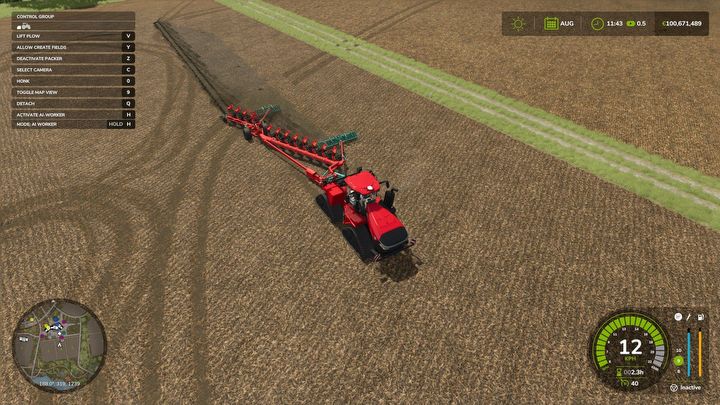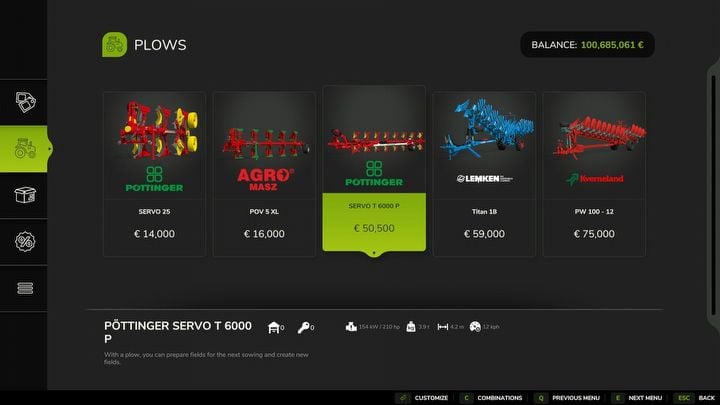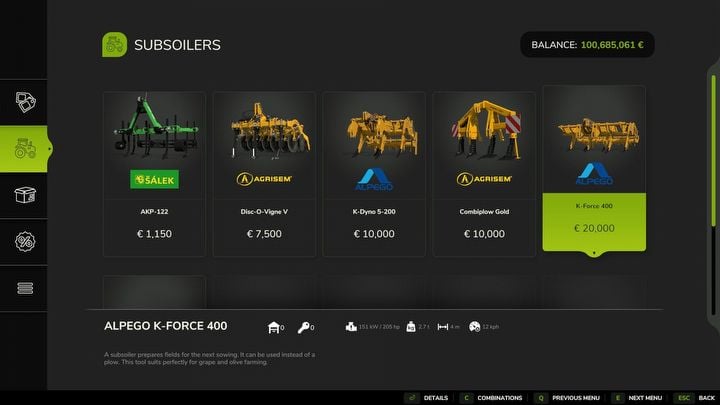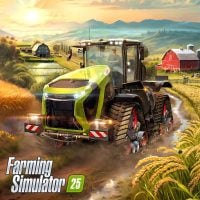Farming Simulator 25: Plowing
Plowing is one of the hardest jobs to do in Farming Simulator 25. On this page of the guide, you'll learn when it's necessary, what it does, and whether it's better to use a plow or a subsoiler.
Last update:
Plowing is one of the first things you should do on a new field in Farming Simulator 25, although it is not always necessary. This is also one of the hardest tasks. On this guide page, you will learn how to plow a field, the benefits of plowing and the differences between a plow and a subsoiler.
- How to plow a field?
- What are the benefits of plowing?
- What is the difference between deep and shallow plowing?
How to plow a field?
Plowing involves turning over the top layer of soil using a plow, subsoiler or a spader. These tools can be attached to a tractor and dragged across the field over bare ground to prepare the soil for cultivation. However, this is a job that requires a high-powered machine, which will be capable of pulling a heavy tool buried in the ground. It is also worth buying and installing a counterweight (press C on the keyboard when choosing a plow or subsoiler in the store) - without it, some machines may turn out to be too heavy, tilting the tractor backwards and preventing it from moving.
What are the benefits of plowing?
Plowing is an activity required for planting root crops (e.g. potatoes, beets, corn, parsnip). After gathering such plants, you must plow the field to make it suitable for further planting. You can plow after harvesting other crops as well, but it's not necessary - cultivation will suffice in that case. If you've plowed your field, you don't need to cultivate it.
Occasionally, from time to time, you will have to plow each field, regardless of what you plant on it. It's called a periodic plowing - however, this functionality can be disabled in the options. The game will let you know when the field requires plowing.
There are two types of plowing - deep (performed with a plow) and shallow (performed with a subsoiler or a spader). Both types share two main advantages - they allow further cultivation of root crops and increase the amount of crops in the field. They also share one disadvantage - they dig up stones from the ground that will damage your machines unless you immediately pick them up. Deep and shallow plowing also have their exclusive advantages and disadvantages.
What is the difference between deep and shallow plowing?
Deep plowing with a plow is slow and requires a powerful tractor. In return, however, it prevents the growth of weeds in the field and allows for the expansion of fields and the creation of entirely new fields. It also extracts smaller stones from the ground, which are then easier to remove. Deep plowing is time-consuming but rewarding.
Shallow plowing with a subsoiler or a spader is much faster and lighter. However, it does not prevent the growth of weeds, does not allow for the expansion of fields and brings out larger stones. This makes the subsoiler ideally suited for periodic plowing of non-root crops. In addition, some subsoilers can be equipped with additional modules, e.g. a seeder or fertilizer spreader. This will allow you to perform several tasks at once, saving even more time.
- Farming Simulator 25 Guide
- Farming Simulator 25: Game Guide
- Farming Simulator 25: Cultivation of plants
- Farming Simulator 25: Order of field work
- Farming Simulator 25: Plowing
- Farming Simulator 25: Cultivation
- Farming Simulator 25: Lime spreading
- Farming Simulator 25: Stone picking and soil rolling
- Farming Simulator 25: Sowing and planting
- Farming Simulator 25: Weeding
- Farming Simulator 25: Fertilizing
- Farming Simulator 25: Harvesting
- Farming Simulator 25: Mulching
- Farming Simulator 25: Straw
- Farming Simulator 25: How to grow grass?
- Farming Simulator 25: How to make hay?
- Farming Simulator 25: Storing resources
- Farming Simulator 25: How to grow grains?
- Farming Simulator 25: How to grow potatoes?
- Farming Simulator 25: How to grow sugar beets?
- Farming Simulator 25: How to grow sunflowers and corn?
- Farming Simulator 25: How to grow sugarcane?
- Farming Simulator 25: How to cultivate long grain rice?
- Farming Simulator 25: How to grow rice?
- Farming Simulator 25: How to grow root vegetables - carrots, parsnip, red beet?
- Farming Simulator 25: How to grow grapes and olives?
- Farming Simulator 25: Cultivation of plants
- Farming Simulator 25: Game Guide
You are not permitted to copy any image, text or info from this page. This site is not associated with and/or endorsed by the developers and the publishers. All logos and images are copyrighted by their respective owners.
Copyright © 2000 - 2025 Webedia Polska SA for gamepressure.com, unofficial game guides, walkthroughs, secrets, game tips, maps & strategies for top games.



